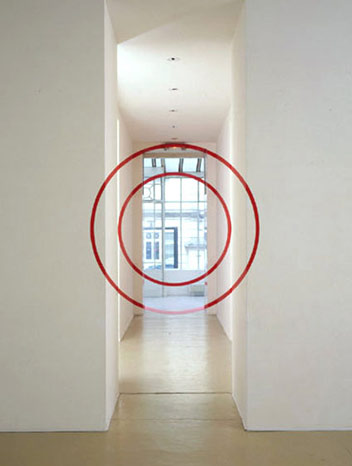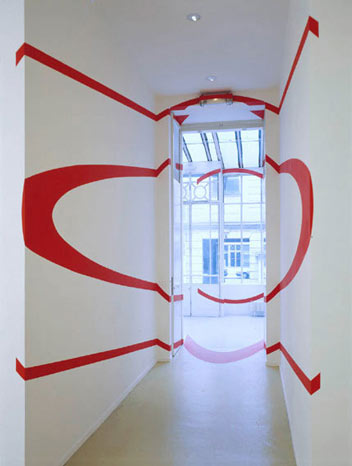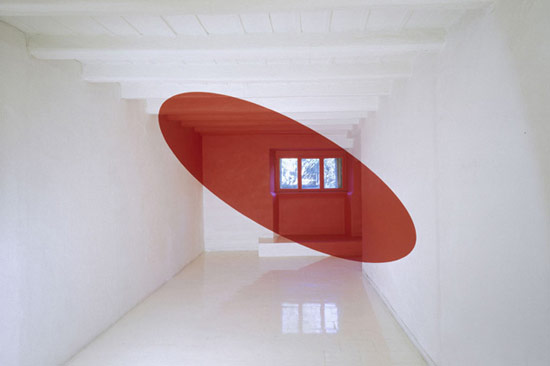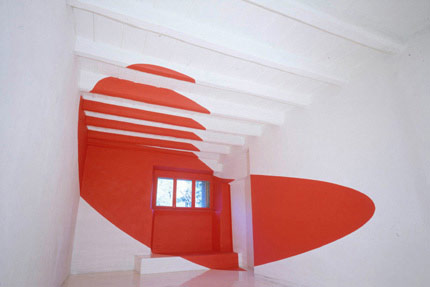Absolutely love this infrared animation of Discovery Bay, Hong Kong!
I recently tried B&W lens filters ( red and orange) and the results can be really great!
Below is just one example of cloudy sky shot on a sunny day with clear blue sky. The orange filter made the sky darker and underlined the texture of the clouds. I can only imagine how great the results would be using an infra-red camera!
I'm definitely going to practise shooting with orange/red filters. I really like the dramatic effects they help achieve.
Old Factory - South Circular Road
Camera - Nikon N80
Focal length - 50mm
Lens Filters - Orange
Aperture - f/11
Shutter Speed - 1/90s
Film - ILFORD HP5 PLUS 400
under the waves of light
Monday, November 8, 2010
Thursday, October 21, 2010
Felice Varini - Optical Illusion Art
I was reading the other day about the optical illusions created by the Swiss artist Felice Varini. He turns rooms and other spaces into geometric perspective-localised paintings. He usually uses very simple geometric shapes such as circles, triangles etc. He paints the chosen space and ends up with a 3D painting. The complete painting can be seen by the viewers from one vantage point. The painting appears broken or misshaped from other view points. Varini is interested in what happens to the viewers outside the vantage point of view where the complete painting no longer exists. Instead it comprises multiple fragments creating reality that appears somewhat abstract, reality that can be interpreted by each viewer in their own way (the full interview with Varini can be found here: http://www.poeticmind.co.uk/interviews-1/i-am-a-painter/).
Varini creates this interesting reality allowing us to look at the same thing, the same shape from different perspectives. It's amazing - the amount of perspectives you can get just by changing your point of view!
Below are some examples of Varini’s work ( first image seen from the vantage point of view and the second one seen from outside the vantage point). Pretty cool, isn’t it?
Two Circles In Corridor, Red No. 1 (1992), Paris, acrylic paint (seen from the vantage point)
Two Circles In Corridor, Red No. 1 (1992), Paris, acrylic paint (seen from outside the vantage point).
Ellisse Rossa Piena per la Finestra (1995), acrylic paint (seen from the vantage point)
Ellisse Rossa Piena per la Finestra (1995), acrylic paint (seen from outside the vantage point)
Varini uses three-dimensional spaces instead of the canvas. He calls himself a painter rather than an installation artist.
Installation art describes an artistic genre of site-specific, three-dimensional works designed to transform the perception of a space(…)The genre incorporates a very broad range of everyday and natural materials, which are often chosen for their evocative qualities, as well as new media such as video, sound, performance, immersive virtual reality and the internet. Many installations are site-specific in that they are designed to exist only in the space for which they were created. (http://www.answers.com/topic/installation-art)
Links:
Images and image captions : http://www.poeticmind.co.uk/interviews-1/i-am-a-painter/Wednesday, October 13, 2010
Steve McCurry - Child Labour
Steve McCurry,a famous photographer, especially known for his photograph of the green-eyed Afghan girl, depicts child labour in various countries of the world (particularity in Asia and Africa). He includes several images of child labourers in his blog,bringing awareness to the exploitive work and the difficult working conditions.
One of his images illustrates an eleven-year-old Philippine boy working in gold mine. The photograph ( taken in 1985) shows us the hazardous conditions in which children of developing countries are forced to work. The viewer's eye is drawn to the eyes of the boy which are located in the top area of the image. His gaze evokes sympathy. The torch on his head and the dark background describe the poor light conditions of the workplace and the danger to which he is exposed.
The boy who is the central subject of the image appears distressed. He is not too emotional. He is holding a shovel and seems to be confident in his pose. This only proves that he must have been working as a miner for quite a long time. The scene is disturbing and makes us reflect on the conditions of child labour in developing counties and the consequences of such situation.
An eleven-year-old boy working in gold mine, Mindinao, Philippines, 1985
McCurry has an uncanny ability to make his subjects forget about the camera. This helps him capture the real human condition.
'I try to convey what it is like to be that person, a person caught in a broader landscape that you could call the human condition.” (Steve McCurry)
Patience is the key. McCurry says:
“If you wait,people will forget your camera and the soul will drift up into view' . (Steve McCurry)
External links:
Steve McCurry blog: http://stevemccurry.wordpress.com/2009/12/01/children-at-work/
Wednesday, October 6, 2010
Henri Cartier-Bresson - About the 'decisive moment'
“For me the camera is a sketch book, an instrument of intuition and spontaneity, the master of the instant which, in visual terms, questions and decides simultaneously. In order to “give a meaning” to the world, one has to feel involved in what one frames through the viewfinder. This attitude requires concentration, discipline of mind, sensitivity, and a sense of geometry. It is by economy of means that one arrives at simplicity of expression.
To take a photograph is to hold one’s breath when all faculties converge in a face of fleeing reality. It is at that moment that mastering an image becomes a great physical and intellectual joy.
To take a photograph means to recognize – simultaneously and within a fraction of a second– both the fact itself and the rigorous organisation of visually perceived forms that give it meaning.
It is putting one’s head, one’s eye, and one’s heart on the same axis.”
Henri Cartier-Bresson
(http://www.henricartierbresson.org/index_en.htm)
Bresson’s concept of the ‘decisive moment’ is perfectly illustrated in his photograph Behind the Gare St. Lazare, 1932. In this photograph Bresson captured the man attempting to jump over the puddle. In order to be able to freeze this particular moment, this tiny fraction of a second, Bresson must have been concentrated, patient and ready for the potential image to reveal in front of him.
The ‘decisive moment’ is about being in the right spot at the right time. Reading about Bresson’s concept made me understand how crucial it is, as a photographer, to stay alert, vigilant and aware of what is happening around us at all times. With this kind of perceptual approach, one will be able to notice and capture the most meaningful seconds of human experience. We must follow our intuition and derive our understanding of the world from within ourselves in order to be able to recognise the ‘decisive moments’.
To take a photograph is to hold one’s breath when all faculties converge in a face of fleeing reality. It is at that moment that mastering an image becomes a great physical and intellectual joy.
To take a photograph means to recognize – simultaneously and within a fraction of a second– both the fact itself and the rigorous organisation of visually perceived forms that give it meaning.
It is putting one’s head, one’s eye, and one’s heart on the same axis.”
Henri Cartier-Bresson
(http://www.henricartierbresson.org/index_en.htm)
Bresson’s concept of the ‘decisive moment’ is perfectly illustrated in his photograph Behind the Gare St. Lazare, 1932. In this photograph Bresson captured the man attempting to jump over the puddle. In order to be able to freeze this particular moment, this tiny fraction of a second, Bresson must have been concentrated, patient and ready for the potential image to reveal in front of him.
Behind the Gare St. Lazare, 1932
Henri Cartier-Bresson
The ‘decisive moment’ is about being in the right spot at the right time. Reading about Bresson’s concept made me understand how crucial it is, as a photographer, to stay alert, vigilant and aware of what is happening around us at all times. With this kind of perceptual approach, one will be able to notice and capture the most meaningful seconds of human experience. We must follow our intuition and derive our understanding of the world from within ourselves in order to be able to recognise the ‘decisive moments’.
Subscribe to:
Posts (Atom)





